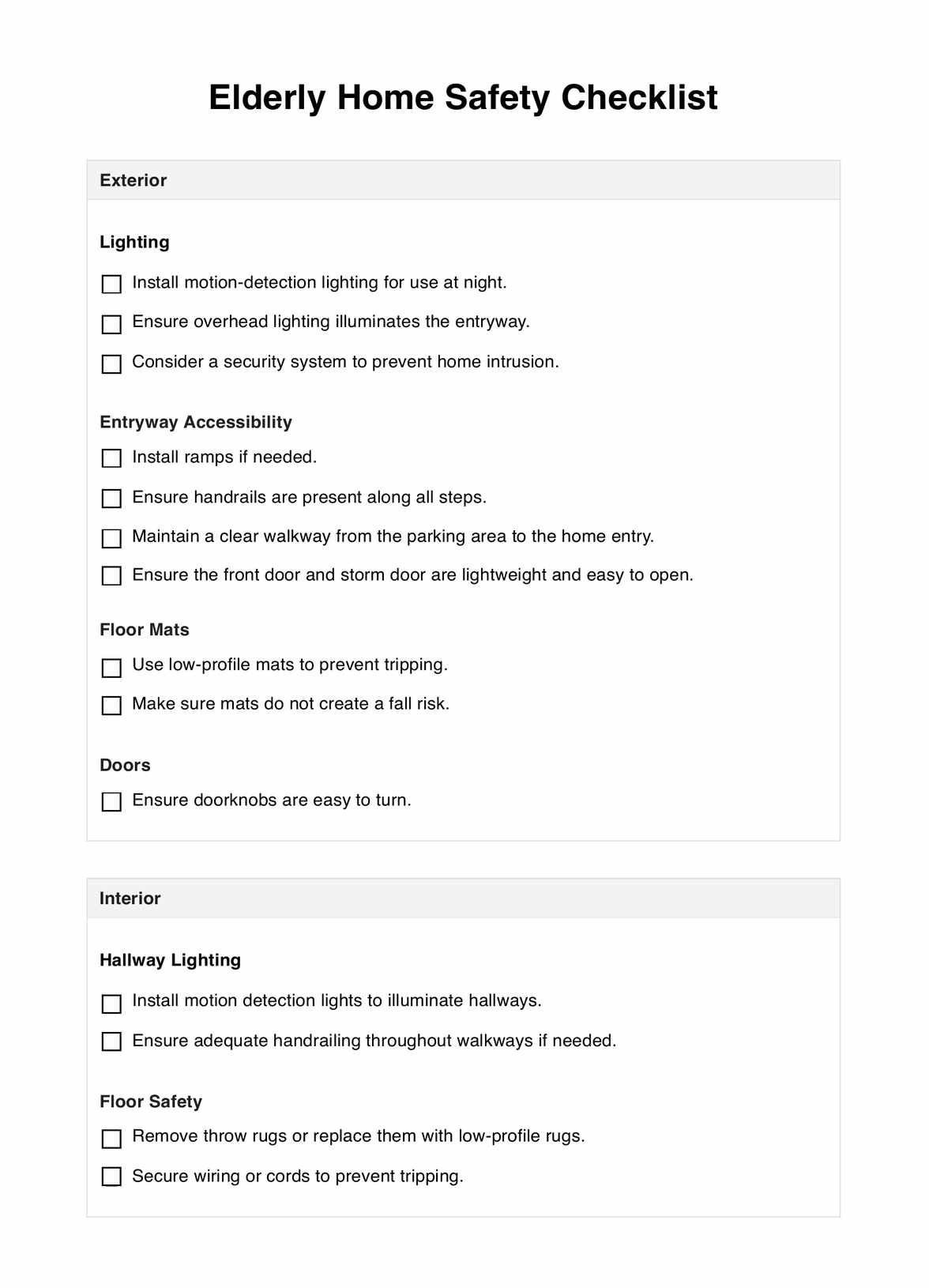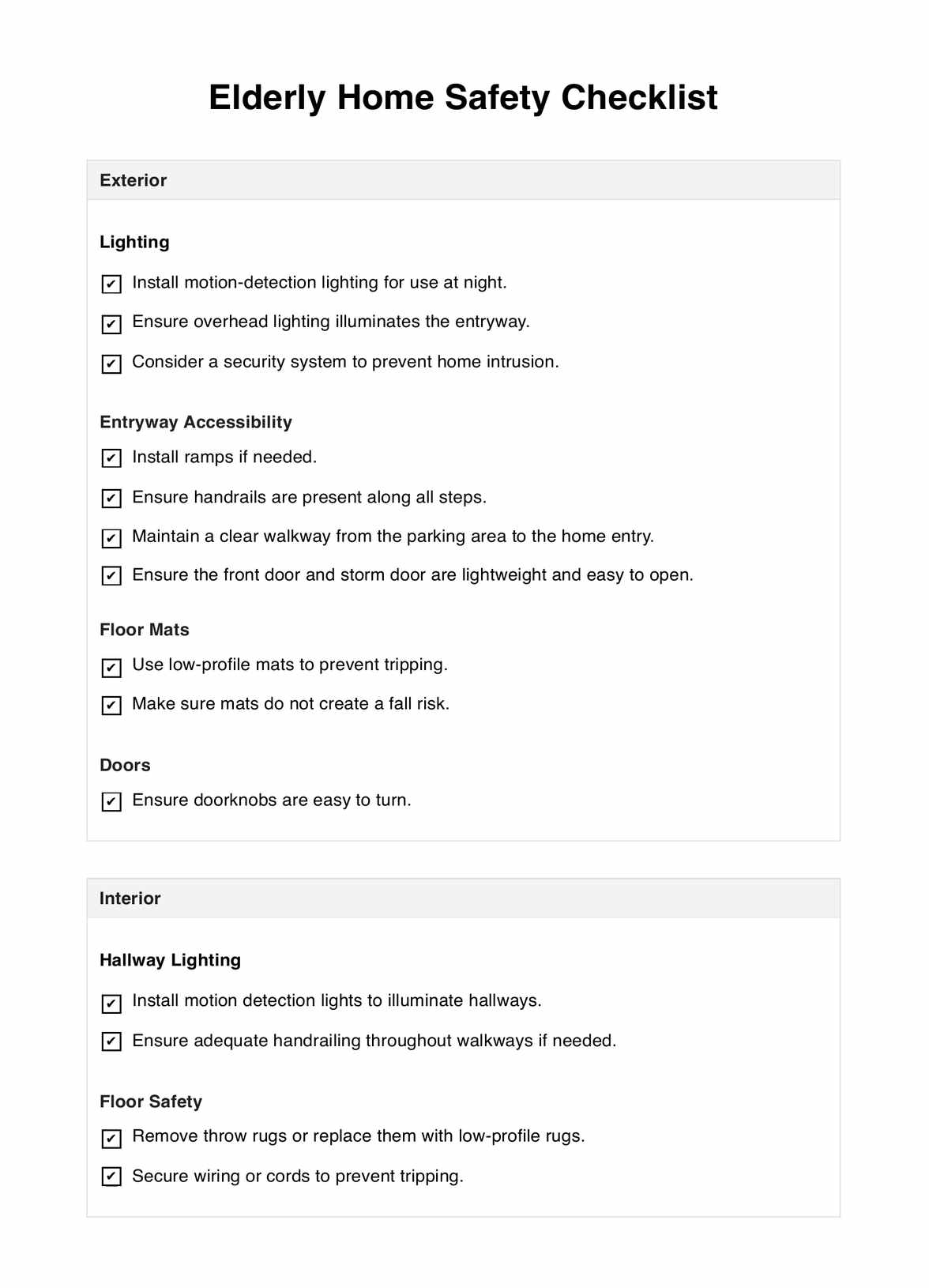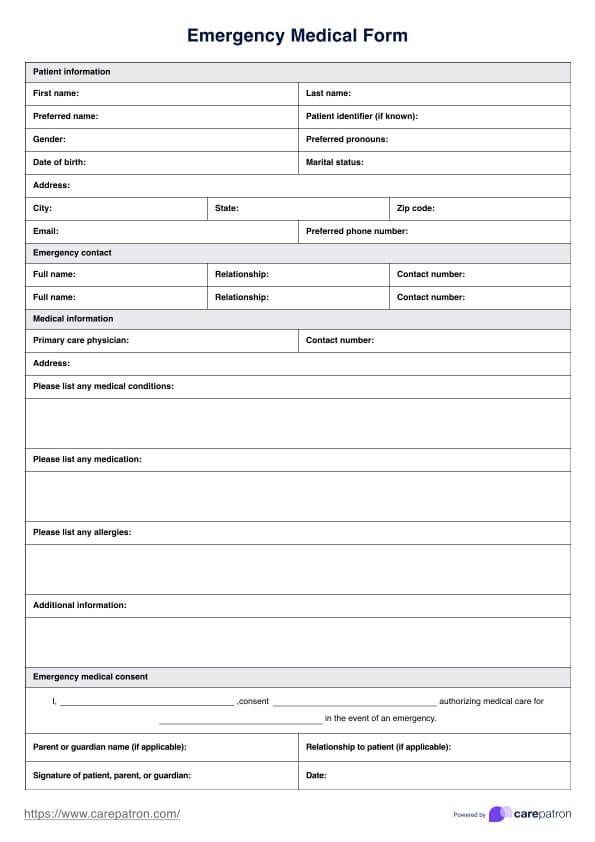Elderly Home Safety Checklist
Want to enhance home safety for seniors? Explore the Elderly Home Safety Checklist Template, ensuring a secure environment. Download now for peace of mind!


What is an Elderly Home Safety Checklist?
The importance of good home safety can't be overstated. Good home safety equates to an environment that reduces risks and promotes one's well-being. Doing so often involves regular home safety evaluations to determine potential hazards and take necessary precautions.
A home safety assessment helps prevent potential hazards, and securing a home environment decreases the risk of accidents and injuries, improving individuals' well-being and providing peace of mind. Effective home safety measures empower individuals to move around their residences with confidence and autonomy, nurturing feelings of safety and relaxation.
Elderly home safety is a critical aspect of aging in place. It focuses on creating an environment that minimizes risks and promotes well-being for seniors. It involves proactive measures to address potential hazards within the living space, ensuring a secure and comfortable atmosphere.
Falls are the second leading cause of unintentional injury deaths worldwide, with approximately 684,000 fatalities annually, predominantly affecting adults aged 60 and above. Such emphasizes the necessity for prevention strategies focusing on education, safer environments, research, and policies (World Health Organization, 2021).
An Elderly Home Safety Checklist is a structured guide assessing and enhancing the safety of a senior's living environment. The checklist covers the home's exterior and interior aspects, including adequate lighting, entryway accessibility, floor safety, stairways, kitchen, living spaces, bedroom, and bathroom. It includes recommendations for essential safety products like medical alert systems, smoke alarms, and carbon monoxide detectors and offers insights into financial assistance options.
Safety assessments are not limited to an older adult's home. In fact, organizations also conduct safety assessments to protect their establishment, personnel, and staff, which is usually done with the help of a Safety Assessment tool.
Elderly Home Safety Checklist Template
Elderly Home Safety Checklist Example
How Does it Work?
Ensuring a safe living environment for seniors involves a thorough home assessment. Follow these five steps to utilize the Printable Elderly Home Safety Checklist Template:
Step 1: Download the Checklist
Access the Printable Elderly Home Safety Checklist Template, available in a downloadable and printable format.
Step 2: Begin Exterior Assessment
Commence with the exterior checklist, evaluating lighting, entryway accessibility, floor mats, and door safety. Mark each item based on observations and necessary actions.
Step 3: Explore Interior Safety
Move indoors, examining hallways, stairs, kitchen, living areas, bedroom, and bathroom. Note down potential hazards and implement safety measures as required.
Step 4: Consider Essential Products
Evaluate the need for essential safety products like medical alert systems, GPS trackers, hearing aids, emergency cellphones, and walk-in tubs.
Step 5: Explore Financial Assistance Options
Discover financial aid possibilities such as home improvement grants, long-term material loans, and Medicare coverage. Note relevant details in the checklist.
When Would You Use This Template?
The Elderly Home Safety Checklist Template proves invaluable for various practitioners, caregivers, and families invested in the well-being of seniors. Caregivers can utilize this resource when conducting routine safety assessments for aging individuals living independently. It is a systematic tool to identify potential hazards and implement necessary modifications, ensuring the environment remains conducive to aging.
Healthcare professionals, including geriatric nurses and occupational therapists, can integrate this template into their practice during home visits. Utilizing the checklist, they can comprehensively evaluate the living conditions of their elderly patients, offering tailored recommendations for a safer home environment. Additionally, families and individuals can proactively use the template when considering modifications or improvements to accommodate the changing needs of aging relatives.
Whether assessing an existing living space or preparing for the transition of a senior family member, the Elderly Home Safety Checklist Template provides a structured and thorough approach. Its user-friendly format empowers various stakeholders to collaborate in creating homes prioritizing safety, comfort, and independence for the elderly.
What do the Results Mean?
Upon completing the Free Elderly Home Safety Checklist Template, users gain insights into the safety status of the assessed living space. Common positive results may include well-lit entryways, secure handrails, and clutter-free walkways, fostering an environment conducive to aging in place. These outcomes signify a proactive approach to safety measures, reducing the risk of falls and accidents for elderly residents.
Conversely, identified hazards such as inadequate lighting, tripping risks, or inaccessible entryways indicate areas requiring attention. Results may highlight the need for modifications such as installing handrails, removing tripping hazards, or improving lighting conditions. This insight guides users in prioritizing necessary adjustments to enhance overall safety.
The checklist results act as a roadmap for caregivers, healthcare professionals, and individuals, offering a clear understanding of the home's safety strengths and areas for improvement. Utilizing these findings, stakeholders can collaborate to implement tailored solutions, ensuring that the living environment remains secure, supportive, and suitable for the unique needs of elderly residents.
Research & Evidence
Research on safety in-home care for older adults has steadily evolved, as evidenced by a bibliometric analysis spanning 11 years (Nurs Open, 2021). The study, led by Songmei Cao and colleagues, aimed to understand the current state, main research topics, and collaborative networks in the field. The findings underscore the increasing importance of home care safety for the aging population, emphasizing addressing adverse events, risk factors, fall prevention, medication safety, device safety, and specific populations' needs.
The study highlights the unique challenges associated with home care safety for older adults, emphasizing the need for a comprehensive approach considering the physical environment, caregiver knowledge, medical device application, and care resource availability. As the demand for health care in-home or community settings rises globally, ensuring the safety of elderly individuals becomes crucial.
Drawing from the research, safety measures outlined in the Free Elderly Home Safety Checklist Template align with key areas identified in the study. The checklist provides actionable steps to enhance lighting, prevent tripping hazards, and secure the home environment. By incorporating these safety measures, individuals and caregivers can address identified gaps and contribute to creating secure living spaces for older adults aging in place.
References
Cao, S., Huang, H., Xiao, M., Yan, L., Xu, W., & Tang, X. (2021). Research on safety in-home care for older adults: A bibliometric analysis. Nursing Open, 8(4), 1720–1730. https://doi.org/10.1002/nop2.855
Commonly asked questions
To create one, identify potential hazards, consider the specific needs of the individual, and systematically assess areas such as lighting, flooring, and accessibility.
These are used when assessing or improving the safety of a living environment for individuals, especially during transitions like moving into a new home or adapting to changing health conditions.
It is used by caregivers, family members, or individuals to systematically evaluate and address safety concerns in and around the home, following a step-by-step assessment process.
These can be created by caregivers, family members, or professionals involved in care, tailoring the assessment to the specific needs and circumstances of the individual in question.














































































































